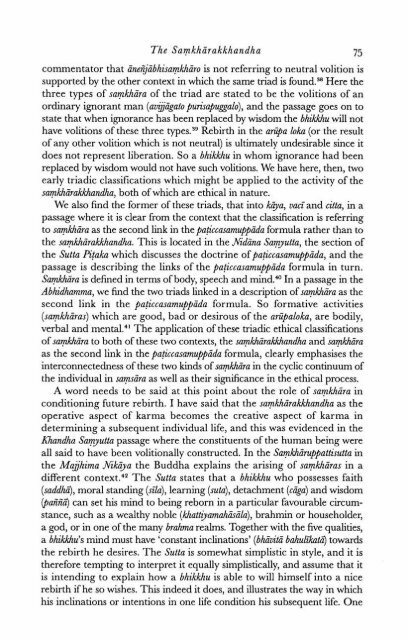Identity and Experience_Hamilton_1996
Identity and Experience_Hamilton_1996
Identity and Experience_Hamilton_1996
You also want an ePaper? Increase the reach of your titles
YUMPU automatically turns print PDFs into web optimized ePapers that Google loves.
The Samkhiirakkh<strong>and</strong>ha 75<br />
commentator that iiner7jiibhisamkhiro is not referring to neutral volition is<br />
supported by the other context in which the same triad is found.38 Here the<br />
three types of samkhiira of the triad are stated to be the volitions of an<br />
ordinary ignorant man (aviiiigato purisapugalo), <strong>and</strong> the passage goes on to<br />
state that when ignorance has been replaced by wisdom the bhiMu will not<br />
have volitions of these three types.39 Rebirth in the ariipa loka (or the result<br />
of any other volition which is not neutral) is ultimately undesirable since it<br />
does not represent liberation. So a bhikkhu in whom ignorance had been<br />
replaced by wisdom would not have such volitions. We have here, then, two<br />
early triadic classifications which might be applied to the activity of the<br />
sapkhiirakkh<strong>and</strong>ha, both of which are ethical in nature.<br />
We also find the former of these triads, that into kiya, urn-<strong>and</strong> citta, in a<br />
passage where it is clear from the context that the classification is referring<br />
to samkhiira as the second link in the paiiccasamuppiida formula rather than to<br />
the samkhiirakkh<strong>and</strong>ha. This is located in the Nidiina Samyutta, the section of<br />
the Sutta Pitaka which discusses the doctrine of pa!iccasamuppiida, <strong>and</strong> the<br />
passage is describing the links of the paticcasamuppiida formula in turn.<br />
Samkhdrd is defined in terms of body, speech <strong>and</strong> mind.40 In a passage in the<br />
Abhidhamma, we find the two triads linked in a description of samkhiira as the<br />
second link in the pa!iccasamuppida formula. So formative activities<br />
(sapkhiiras) which are good, bad or desirous of the ariipaloka, are bodily,<br />
verbal <strong>and</strong> mental.41 The application of these triadic ethical classifications<br />
of satpkhiira to both of these two contexts, the samkhiirakkh<strong>and</strong>ha <strong>and</strong> saWra<br />
as the second link in the pa~iccasamuppiida formula, clearly emphasises the<br />
interconnectedness of these two kinds of samfira in the cyclic continuum of<br />
the individual in sa~iiras well as their significance in the ethical process.<br />
A word needs to be said at this point about the role of samkhiira in<br />
conditioning future rebirth. I have said that the samkhiirakkh<strong>and</strong>ha as the<br />
operative aspect of karma becomes the creative aspect of karma in<br />
determining a subsequent individual life, <strong>and</strong> this was evidenced in the<br />
&$<strong>and</strong>ha Samyutta passage where the constituents of the human being were<br />
all said to have been volitionally constructed. In the Samkhiiruppattisutta in<br />
the Majhima Nikiiya the Buddha explains the arising of samkhiras in a<br />
different context.42 The Sutta states that a bhikkhu who possesses faith<br />
(saddhi), moral st<strong>and</strong>ing (sfla), learning (suta), detachment (tea) <strong>and</strong> wisdom<br />
(pan"n"i) can set his mind to being reborn in a particular favourable circumstance,<br />
such as a wealthy noble (khattiyamahiisiila), brahmin or householder,<br />
a god, or in one of the many brahma realms. Together with the five qualities,<br />
a bhikkhu's mind must have 'constant inclinations' (bhlZviti bahulihti) towards<br />
the rebirth he desires. The Sutta is somewhat simplistic in style, <strong>and</strong> it is<br />
therefore tempting to interpret it equally simplistically, <strong>and</strong> assume that it<br />
is intending to explain how a bhikkhu is able to will himself into a nice<br />
rebirth if he so wishes. This indeed it does, <strong>and</strong> illustrates the way in which<br />
his inclinations or intentions in one life condition his subsequent life. One


